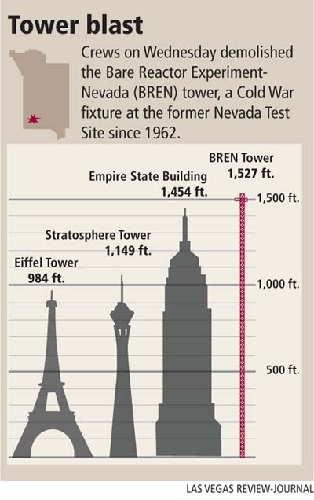Blast brings down 1,527-foot tower at Nevada National Security Site
MERCURY - With blasts from strategically placed explosives, a Cold War relic came crashing down Wednesday at the Nevada National Security Site.
The detonations, more than 65 miles northwest of Las Vegas, ended an era when the 1,527-foot steel tower for the Bare Reactor Experiment-Nevada stood as the highest free-standing structure west of the Mississippi River, and tallest structure of its kind in the world.
The so-called BREN Tower was taller than the Stratosphere, the Empire State Building or the Eiffel Tower.
The BREN Tower's height was the same as the distance above ground that the Little Boy atomic bomb burst over Hiroshima, Japan, on Aug. 6, 1945. Crews constructed the tower in 1962 to hold a cobalt-60 gamma radiation source so that scientists could reconstruct doses received by survivors of the nuclear explosions over Hiroshima and Nagasaki, Japan.
The unshielded, or bare, radioactive source was mounted on a hoist vehicle to move it to various levels on the tower.
"This was a truly spectacular event," said Stephen A. Mellington, the local National Nuclear Security Administration manager who oversees the Nevada National Security Site, formerly known as the Nevada Test Site.
"Watching 345 tons of steel come tumbling down was quite a sight," Mellington said in a statement.
Test site spokesman Darwin Morgan said the BREN tower "served a very important function back in its day," but in recent years without a mission, the tower had become a potential hazard for commercial and military aircraft that might need the test site's restricted airspace in an emergency.
DEMCO Inc. of West Seneca, N.Y., partnered with Controlled Demolition Inc. of Phoenix, Md., to bring down the tower.
In the 1962 dose reconstruction experiment in Yucca Flat, a mock Japanese village was built near the base of the tower for realism to study the shielding effects of various house styles and building materials. The experiment became a cornerstone for estimating radiation doses.
Instruments were placed on the tower to measure weather conditions and transmit the data for the National Weather Service and Sandia National Laboratories.
Because of its location in an area used for below-ground nuclear weapons tests, the BREN Tower was dismantled and moved to Jackass Flats in the southwest part of the test site in 1966 under a $380,000 contract awarded to an Ohio-based company.
In September 1966, the tower was used to conduct Operation HENRE, High Energy Neutron Reactions Experiment, to collect data for national biological research programs and the armed forces.
The BREN Tower was last used for experiments in 1991. After that it cost the Department of Energy roughly $2,000 per year to maintain it and keep its elevator certificate current. The elevator was used to change warning lights required by the Federal Aviation Administration.
The elevator certificate expired in 2003. As lights went out over the years, the tower posed a safety hazard for nearby workers and aircraft. Restoration would have cost more than $1 million.
The tower's demolition provided an estimated $87,000 in scrap steel.
Contact reporter Keith Rogers at
krogers@reviewjournal.com or 702-383-0308.


















